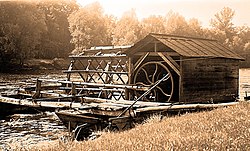Petanjci
Petanjci (German Petanzen, Hungarian Szécsénykút) is a village and part of the municipality of Tišina and is located in Ravensko , the flat part of the historic Prekmurje region in Slovenia .
geography
Petanjci ( 197 m. I. J. ) is an elongated street village and is made up of three parts of the settlement, which, however, merge seamlessly into one another: Dolnji (Lower), Srednji (Middle) and Gornji (Upper) Petanjci. The village is on the main road no. 3, which leads from Maribor via Radenci to Murska Sobota . With an area of 763.7 ha , a population of 649 inhabitants and 280 households (2018), Petanjci is the largest settlement in the Tišina municipality . In the northwest, the village boundary on the Kutschenitza touches the Styrian district of southeast Styria . The western and southern parts of the local area are crossed by the Mur . The riparian forests that accompany the river on both sides form the habitat for a special flora and fauna .
history
The place is first mentioned in 1229 as Pethenegh. At that time, the owner "Petan" sold most of his local property to members of the Nádasdy family . In the later Middle Ages the place is often mentioned: Pethenye (1234), Pethenyed (1238), Petined (1265), Peteunych, Petanicz (1348), Felsepethenich, Kezepsewpethenich, et Alsopethenich (1419), tres Pethanycz (1472). The Hungarian place name Szécsénykút did not develop until the middle of the 18th century in connection with the development and marketing of mineral water springs.
In 1890 the village is officially called Szécsenykút and had 515 inhabitants, 506 of them known as Slovenes, 6 as Hungarians and 3 as Germans. The place belonged to the Muraszómbat district (today Murska Sobota) of Vas / Eisenburg county .
With the Trianon Peace Treaty , the village became part of the Kingdom of SHS . For the place now officially called Petanjci, the following data were determined in the census on January 31, 1921: 556 Slovenes and 1 German, of these 557 residents 546 professed to be Catholic and 11 to the Protestant faith.
The 1931 census found 633 inhabitants; in 1961 there were 728 and the following figures are known for 1971: 775 inhabitants, 157 houses, 170 households and 338 villagers who live exclusively on agricultural income.
Nádasdy Castle
The known historical and archaeological data about the Petanjci moated castle are very modest. The development of the castle could be connected with the settlement of the noble family Nádasdy in Petanjci in 1229. In historical sources, however, the castle is only mentioned in the 16th century.
The Petanjci moated castle stood a little higher in a marshy floodplain by the Rjavec brook and was surrounded by an artificial moat with an earth wall. Traces of the fortifications, which had an area of approx. 85 m by 75 m, are still visible in the ground. It is not known when the castle was abandoned and abandoned or destroyed.
The castle was given a certain importance by the fact that during the re-catholicization , when nineteen preachers and professors - including the astronomer Johannes Kepler - were expelled from Graz by sovereign orders on September 28, 1598 , several of these exiles were temporarily here at the manor of Count Thomas Nádasdy Found accommodation.
The Murska Sobota District Museum carried out exploratory excavations at the supposed location in 1987. The most numerous of the objects found were fragments of clay pots and stove tiles. These clay fragments are mainly provided with plant patterns and geometric decorations, whereby a small fragment (4.7 cm × 6 cm) with the motif of a knight particularly stands out. During the excavations, however, two pieces of glass and several iron nails were found. The age of the tile fragments could be assigned to the years 1490 to 1550. Some of the finds are exhibited in the Pokrajinski muzej in the city of Murska Sobota.
Personalities of the place
- Ivan Vanek Šiftar (born May 26, 1919 in Petanjci, † November 8, 1999 in Murska Sobota), Slovenian scientist, university professor, lawyer, editor, poet and gardener.
literature
- Ivan Zelko: Historična Topografija Slovenije I , Prekmurje do leta 1500, Murska Sobota, 1982.
- Atlas: Slovenije . Ljubljana, 1985.
- Jože Sraka: Prekmurci in Prekmurje . Chicago, 1984.
- Matija Slavič: Naše Prekmurje , Murska Sobota, 1999. ISBN 86-7195-316-5
- Ivan Zelko : Zgodovina Prekmurja , Murska Sobota, 1996. ISBN 86-7195-203-7
Coordinates: 46 ° 39 ' N , 16 ° 4' E


